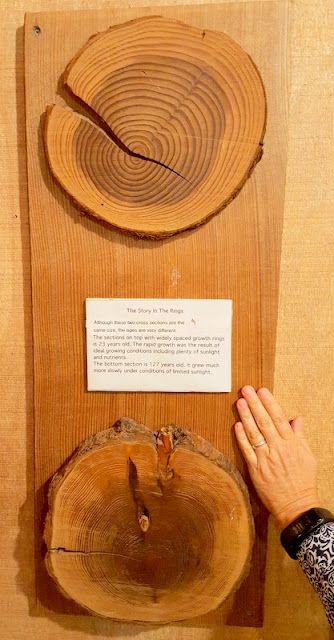 We've had a couple days with rain showers, so we were looking forward to a clear day as we left the motor home this morning. We enjoy learning about the local areas where we are camping, so we headed to the tiny town of Garberville to find the nearest post office to drop off some mail. As we drove through town, we saw a group forming and looking upward. So of course, we parked and joined the crowd to see what was happening this morning. We found that they were taking advantage of the beautiful weather to cut down an old redwood in town.
We've had a couple days with rain showers, so we were looking forward to a clear day as we left the motor home this morning. We enjoy learning about the local areas where we are camping, so we headed to the tiny town of Garberville to find the nearest post office to drop off some mail. As we drove through town, we saw a group forming and looking upward. So of course, we parked and joined the crowd to see what was happening this morning. We found that they were taking advantage of the beautiful weather to cut down an old redwood in town.By the time we got there, they had already removed all the branches and several sections from the top of the tree. We found a comfortable place and settled in to watch the process.
We were also lucky to situate ourselves next to a talkative local citizen, so we found out much about this community while we watched the tree. We found out that this company is the best at taking down these giants. He had hired them to remove a tree on his property too.
That single climber has been up the tree for a couple hours already. There is a limp safety rope attached to him, and he is moving around the huge trunk with the help of spikes strapped to the sides of his boots. He makes moving around that tree look easy, but he is having to drive those spikes hard into the tree with every step.
Even though we love to walk among the redwoods, our new friend explained that they aren't good neighbors in town. Their roots are hard on sidewalks, roads, and plumbing systems; and their branches can be fatal to roofs. There had been a small protest this morning, trying to preserve "the last redwood left in Garberville." But it was obviously not successful as we watched the logger start up his chain saw to take down another section.
He started by making a very precise notch. He continued to trim until he got a smooth surface. Our local information source explained that they have to control where these pieces fall precisely. In the middle of town there are other buildings and other spectators around, so they have to hit their target to avoid damaging things. The target is a bed of old tires on the ground.
He made one more incision on the lip of the notch to help control the fall more precisely. Then he moved to the other side of the log to make the final cut as the cable attached to the ground helped to tilt the log. All together now, can we yell, "TIMMMMMM. . . "
BERRRRRR!" That twenty foot chunk of tree hit the target of car tires with quite a crash! Based on the size of the trunk, we are guessing we were watching a tree that took 500 years to grown up, come down in a single day.
After such an interesting stop in Garberville, we're heading out to explore more of the giant redwoods still standing in our neighborhood. We stopped by the Humboldt Redwood State Park Visitor's Center because we always get good local advice at places like this. For example, we saw a cross-cut of two pieces of redwood that were the same diameter. When counting the rings, however, we see they are very different ages. The one on top obviously had good sunlight and water, so it grew to that diameter in just 23 years. But the tree on the bottom has closely spaced rings, indicating that it had a hard life and grew very slowly. The tree at the bottom had lived 127 years to attain that same size.
They also had an early version of an RV on display. Built on an army Nash Quad frame, the living quarters were carved out of a single redwood tree. Charles Kellogg called it his "Travel-Log."
Built in 1917, he used this as his traveling home. His beautiful solid wood rolling log had all the comforts of home. This local travels just like us.
While at the visitor's center, we also got good local advice on how to spend the rest of our day. We started with the one-mile nature trail loop right across the road. We love walking among these "cloud sweepers," and you can barely see Denisa at the base of one of the trees.
After a couple days spent with 300-foot-tall trees, we are beginning to develop pain in our necks. Mark snapped this picture of Denisa walking through the forest with an arched back and uplifted head. We are starting to walk this way everywhere we go now.
These ancient redwoods have lived through more than one forest fire, as evidenced by the charred scar on the bottom of most of their trunks.
Sometimes the fire will burn through part of the trunk and into the interior of the tree. But as long as the layers close to the bark remain, the tree will survive even with a hollow center. Mark is standing in the center of a huge old redwood, and we were surprised that it is hollow even two feet underground.
The ranger also suggested that we make the trip to the Rockefeller Grove about ten miles away. In the early 1900's, Rockefeller donated one million dollars to purchase this pristine grove of ancient trees in order to save it from being logged. He followed that donation with another million so we could enjoy this large Rockefeller Grove today.
We found more fire-hollowed trees in this forest, and Mark seems to like to crawl into those creepy dark interiors. You can barely see him peeking out, as he is standing well below ground level.
A local we met called these "goose pens"--perhaps because they are big enough to pen your geese up inside?
Actually, the hollowed interior is bigger than some RVs. It's amazing that this is part of a healthy tree that is around 300 feet tall.
We were blessed with blue skies this day, with the sun shining through the redwood canopies to the forest floor. This was the favorite picture of the day--taken with Denisa spotlighted in that rare sunshine among these giant trees. We have wandered into His wonders once again!
The canopies of the tall trees block out most of the sunshine needed for young trees on the forest floor to grow. It's a little hard to see with all the big boys behind, but Denisa is standing beside a young redwood tree. It's hard to imagine that this spindly young tree could one day be as big and majestic as his neighbors.
Mark loves these tall giants, and after two days of wandering through the forests he is looking for new ways to take pictures of them. How about straight up to the sky?
On the other hand, Denisa is more likely to be looking down to the ground to see what is blooming on the forest floor.
This is a rare treat to find. Trillium has three leaves, and forms a three-petaled bloom. This plant has a short bloom season, so it's fun to find one of these little gems in the Rockefeller forest.
We knew these redwoods were tough, but this tree had an especially rough life. Thought to be around 1,000 years old, it is named the "Immortal Tree" for more than one reason. Its top canopy was lost to lightning. The axe on the trunk is pointing to the sight where loggers tried to fell the tree in 1908. There's a fish on the trunk, indicating the depth of the water on the tree during the flood of 1964. Also, it has survived more than one fire.
As we drove further down the narrow Avenue of the Giants, Mark saw something in the upper dead branches of one of the trees growing near the road. Don't ask how he can navigate the twisting curves and narrow roads and still spot a speck in a 300-foot-tall tree.
He even saw that the speck had a white head. He had spotted yet another local--a bald eagle. The big bird was surveying the ground from his perch in those dead branches.
Even though we were very close to the base, when a bird is at the top of a 300-foot-tall tree it's hard to get a good picture. But we could definitely confirm that we were blessed to see an adult bald eagle today.
The ranger this morning recommended good places to see big trees. But he also recommended the best place to see big ferns. This hike has enough open area for fields of ferns, some shoulder high.
All the rain we've been "enjoying" has made this into one of the greenest places we have ever seen. Wherever there is an open spot, something is growing. Many times that open spot is on top of a fallen log in the forest. These old redwoods are rich in organic matter that the ferns thrive on.
Many things grow well here. The local we talked to this morning pointed out that this is the center of the "emerald triangle." We weren't familiar with that term, so he went on to explain that this is the best place to grow marijuana. The newly passed recreational marijuana bill in California has opened up a whole new industry for small towns in the emerald triangle. He pointed out that all the greenhouses and water tanks we see are evidence that people in this area are finding a new and very lucrative money crop.
Our last local experience came just across the street from our campground. Our camp host mentioned that a tornado came through just a couple weeks ago. He proudly described his location on the porch as we watched it touch down and take out part of a grove beside the campground. He also mentioned that a tree fell on a car in the parking lot across 101 from us. The smashed car and the trimmed-up tree are still in the parking lot. It looks like it might become a permanent display in another of those touristy stops that hope to lure passing cars into their souvenir shops.
This shop's claim to fame is its proximity to the "Grandfather Tree." Its credentials include being 1800 years old with a 24-foot diameter.
The shop next door is hoping to lure tourists in with their log house that was made from a single log. There's also the store down the road with the Big Foot display, and the House of Curiosities. This section of Highway 101 is obviously heavily-traveled by tourists looking for some reason to get out of their car, and these locals are trying to lure them in.
We got more local stories and introductions when we went to church on Sunday morning. The local hardware store owner is now pastoring a church that has enjoyed good growth here in the Emerald Triangle. Spending four days in the area gives us a chance to rub elbows with the locals and learn more about life in a new part of the country. This wandering is very educational.












































0 Response to "Learning From the Locals"
Post a Comment